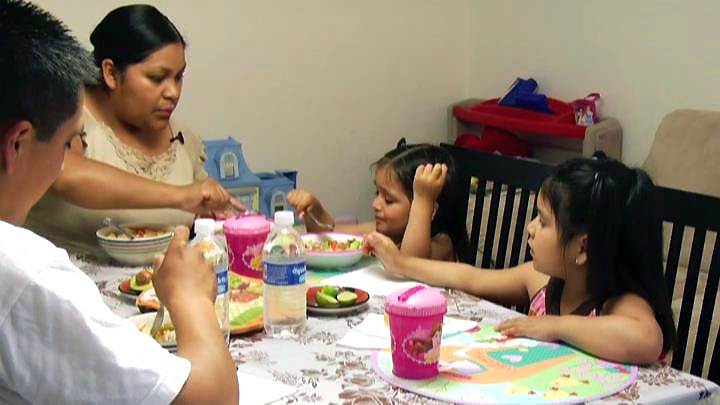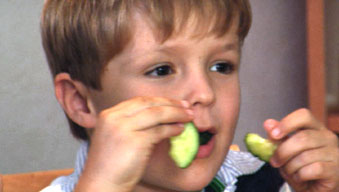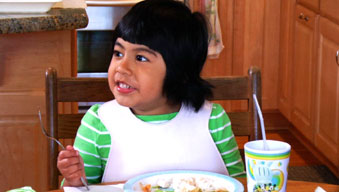
Children's eating and growth

Raise a healthy child who is a joy to feed
Maintain the quality of your feeding relationship rather than worrying about what or how much your child eats. Focus on how you feed and how your child feels and behaves at mealtime, not on what your child eats. Follow the division of responsibility in feeding. Your child will eat and grow well and, sooner or later, he will learn to eat almost everything you eat.
Your child is a competent eater when . . .
- He feels good about eating. He enjoys food and joins in happily with family meals and snacks.
- He enjoys meals and behaves nicely at mealtime. He feels good about being included in family meals and does his part to make mealtime pleasant. He does not make a fuss.
- He picks and chooses from food you make available. He is okay with being offered food he has never seen before. He says “yes, please,” and “no, thank you.” He ignores food he does not want and also “sneaks up” on new food and learns to like it. Eventually he will learn to eat almost everything you do.
- He determines for himself how much to eat. Only he knows how much that is. Trusting him to eat as much he needs lets him grow consistently and develop the body that nature intended for him.
Your eating-competent child may still be picky
- To eat only one or two foods from any meal
- To eat a food one time and ignore it another
- To eat a lot one time and not much another
- To not eat vegetables.

Children know how much they need to eat
Following the division responsibility in feeding preserves your child’s her sensitivity to her internal sensations of hunger, appetite, and satiety. That sets her up for a lifetime of eating as much as she needs and weighing what is right for her. All children know how much to eat: the large child and the small child, the big eater and the small eater. Even children who love to eat get filled up. Trust your child to eat the amount that is right for her. Trying to get her to eat less or more will backfire and create the very problem you are trying to prevent.
Your child may eat a lot or a little, be big or small
- Sometimes your child will eat hardly anything. Other times she will eat more than you can ever imagine. It is all normal.
- Exceptionally big or small children can make their parents so nervous that they interfere with their eating.
- Large children (or any children) who don’t get enough to eat – or fear they won’t – think about food all the time and eat a lot when can.
- Small children who have food pushed on them get turned off by food and tend to eat less when they get the chance.
Trust your child to eat as much as she needs
- Do your jobs with feeding and let your child do her jobs with eating.
- Be considerate without catering in your family meal planning. Combine familiar with unfamiliar, eaten with not-yet eaten.
- Offer sit-down snacks between meals. Don’t give food or drink handouts, except for water.
- Let your child grow up to get the body that is right for her.
- Trust her to make up for her mistakes in eating.

How children learn to eat new food
Your child is learning to eat what you eat. For a young child, all foods are new, even those that are very familiar to you. Eating a variety of food is a skill that children learn gradually.
Understand how children learn
- Children look, touch, taste, smell, and take in and out of their mouths. They watch us eat. If we eat it, and enjoy it, they assume, “someday I will eat that, too.”
- Even after your child eats a food, he won’t eat it every time.
- He is unlikely to eat some of everything from the meal, but only one or two foods. Let him have seconds and thirds on what he enjoys, even if he ignores the rest.
- They find some tastes and textures challenging, such as Brussels sprouts or oysters.
- They quickly learn to eat high-fat and/or high-sugar foods. Children do one-trial learning with cookies and French fries.
- Be considerate without catering in meal planning
- Pair familiar with unfamiliar, eaten with not-yet eaten. Include the not-yet food(s) 15 or 20 or dozens of times – in as many meals.
- Stop counting and enjoy your own food. Your child’s learning could take months or even years.
- Take “no thank you” for an answer. No pressure, bribing, cheerleading, enthusing, saying it’s healthy.

Your child will grow up to get the right body
Your child has a natural way of growing that is right for her, and she knows how much she needs to eat to grow that way. She is born as a wonderful package with everything in balance: her growing, her eating, and her activity. You don’t need to worry about her growing normally – it will happen. You just have to maintain a division of responsibility in feeding and a division of responsibility in activity.
It’s about genetics
- Your child’s body shape and size are mostly inherited.
- She will resemble you with respect to being big, small, or in-between.
- Her height and weight are normal for her, even if she plots above the 97th or below the 3rd percentiles.
- There can be a problem if her weight or height abruptly and rapidly shift up or down on her growth chart.
- Then, consult a health professional who understands feeding dynamics to rule out health, feeding, or parenting problems.
Unusually large or small children need good social skills
- Don’t try to change your child’s size or shape: it will backfire.
- Instead, concentrate on teaching your child to cope.
- Help her develop good character, common sense, effective ways of responding to feelings, problem-solving skills, and the ability to get along with others.
Help your child grow in the way that is right for her
- Feed in the best way. Follow the division of responsibility in feeding
- Follow the division of responsibility in activity.
- Limit television, and give your child opportunities to be active.
- Feel good about the body your child has, not the one you thought she would have.

How children become competent eaters
It takes time – years, in fact
- She will enjoy a variety of food
- She will know how to learn to like new food.
- She will eat the right amount of food to grow in the way that nature intended.
- She will know how to behave at the table so others enjoy having her there.
Your child learns eating skills step by step
- By the time she is 8 to 15 months old, she is likely to be sitting up to your family table and finger-feeding herself soft table food.
- As she gets older, she gradually learns to enjoy more and more of the foods you enjoy
- She gets less messy: She manages the mechanics of eating in more and more grownup ways.
- In late school age and high school, she gradually learns to manage food so she can feed herself after she leaves home.
You are raising your child to do well with a lifetime of eating
- Be consistent with structure, and keep your nerve about what and how much your child eats.
- Trust your child to eat, move, and grow in the way that is right for her.



